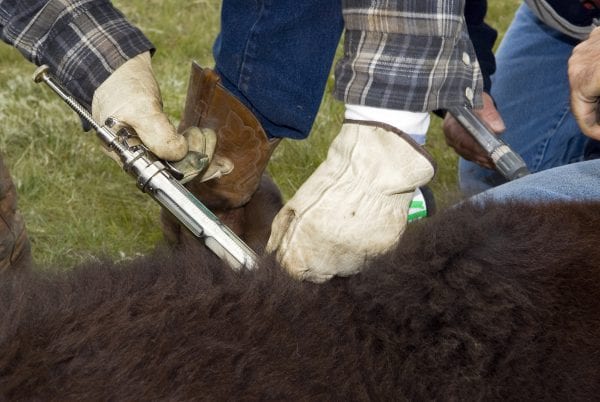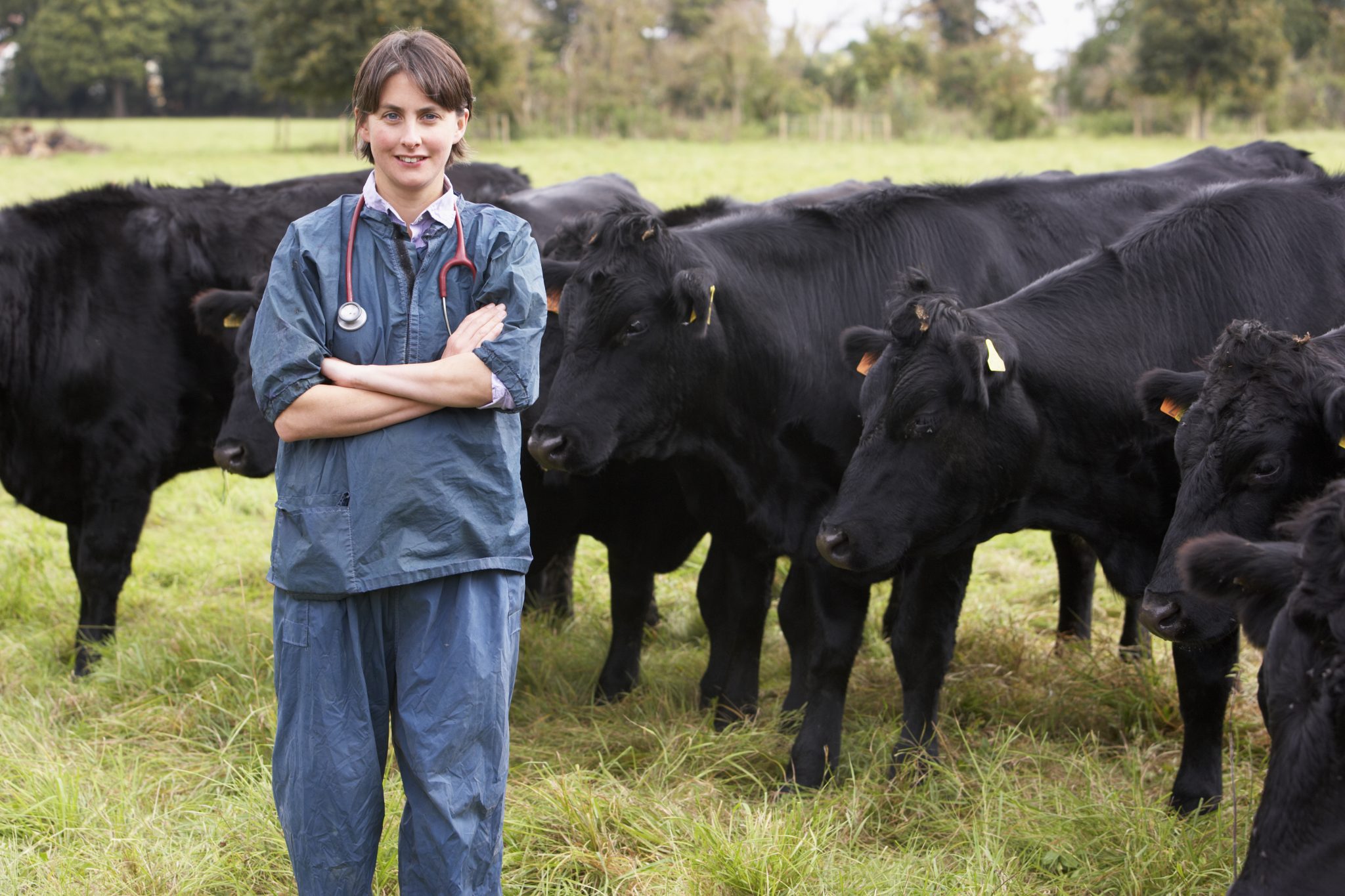Beef

To ensure the proper use and effectiveness of cattle health products, beef producers must use FDA-approved products and use them only as directed by the label or veterinary prescription (if all requirements are met). All products must be properly stored and handled for intended effect.
One of the advantages of participating in a quality assurance program is the constant review of procedures for handling, using, and storing cattle health products. There is a potential for improved profit, whether by reducing waste or improving drug effectiveness. All products purchased for your cattle have a purpose. However, if you do not handle or administer cattle health products properly, you may not see the benefit you are paying for.
Use Only FDA-Approved Drugs
Drugs approve by the Food and Drug Administration (FDA) meet stringent requirements. They have been thoroughly tested to demonstrate that they consistently perform the way the manufacturer claims, that they will not harm the animal when administered according to label directions, and that food products derived from treated animals are safe for human consumption following an adequate withdrawal time.
Types of FDA-Approved Drugs
- Over-the-counter(OTC)
FDA-approved OTC drugs are those that can be purchased and administered by anyone without a veterinarian’s prescription. Examples include, but are not limited to, cattle dewormers, most vaccines, and a few antibiotics. OTC drugs must be administered according to FDA-approved label directions, unless following a veterinarian’s prescription. If you have any questions about the product, talk to your veterinarian, because understanding the product label is the most important part of administering these medications. - Prescription(Rx)
Prescription drugs cannot be administered by cattle producers unless prescribed by a veterinarian. Most antibiotics fall into this category. Prescription drug labels will contain the statement “Caution: Federal law restricts this drug to use by or on the order of a licensed veterinarian.” - VeterinaryFeedDirective(VFD)
All antibiotics administered through animal feed that are also important in human medicine require a written Veterinary Feed Directive from a veterinarian.
Extra-Label Drug Use
In general, animal health products should only be administered to cattle according to FDA-approved label directions. An exception to this rule for both OTC and prescription drugs is called extra-label drug use. This means using animal health products in ways not specified on the label—for example, at higher doses, via a different route of administration, or in a different species. Extra-label drug use requires a veterinarian’s prescription. In addition, these criteria set by the FDA must be met:
- A valid veterinarian/client/patient relationship must be established. In such a relationship, the veterinarian agrees to take responsibility for making judgments regarding the health of the animal(s) and the need for medical treatment, and the client agrees to follow the veterinarian’s instructions.
- A determination must be made that there is no approved drug labeled to treat the condition or that treatment at the recommended dosage of an approved product would not be effective.
- A record of any animal given extra-label treatment must be maintained. This can be done on a herd or individual basis.
- The withdrawal time prior to marketing an animal for slaughter must be significantly extended, as determined by the veterinarian.
- Extra-label drug use for production purposes such as weight gain, feed efficiency or milk production is inappropriate. Extra-label use of drugs in animal feeds is strictly prohibited.
- A list of drugs that are prohibited from extra-label uses in food producing animals can be found on the FDA’s website.
You, as the owner of the animals, are ultimately in charge of making sure meat does not contain illegal drug residues. Your responsibilities are to make sure a careful diagnosis has been made based on your herd- health history and/or individual animal examination, to identify all treated animals and keep treatment records, and to follow veterinarian-recommended extended withdrawal times.

Understanding Drug Labels
Become familiar with requirements for drug labeling. You are ultimately responsible for any drug residues in your animals. Fortunately, you should not have to worry about the accuracy of drug labels, because the drug manufacturer must meet all FDA requirements prior to drug approval, and your veterinarian is responsible for all other labels on drugs that he or she prescribes for your animals. All drugs, whether OTC or prescription, must contain the following basic information on the label:
- Name of drug
- Active and inactive ingredients
- Drug concentration
- Uses (indications) for the product
- Route of administration
- Dosage instructions
- Storage instructions
- Specific warnings
- Withdrawal times
- Quantity of contents
- Name of distributor
- Expiration date
- Lot number
In addition to these basic requirements, prescription drugs must contain the following information on the label:
- Name, address, and telephone number of the prescribing veterinarian
- Client’s name
- Identification of animal(s) treated, species, and number of animals treated, when possible
- Date of treatment, prescribing, or dispensing of drug
- Number of refills
- Cautionary statements, as needed
To help reduce the chance of adverse reactions and minimize the risk of residues, check and follow these instructions on each label:
- Dosage (example: 2 mL or cc per 100 pounds body weight)
- Frequency (example: 2 doses, 3 to 4 weeks apart)
- Route of administration (For more information, please refer to ANR-1280, “Administering Cattle Health Products Properly.”)
- Warnings (example: Not for use in pregnant animals)
- Withdrawal times, if any (example: Do not use within 28 days of slaughter.)
- Storage (example: Store at 2 degrees to 7 degrees C)
- Disposal (example: Burn container and all unused contents.)
- Expiration date
Familiarize yourself with the label example at the end of this document. Failure to understand a drug label is not a valid defense if milk or meat from one of your animals is found to contain drug residues.
Storing Drugs Correctly
Drug performance declines if the expiration date has passed, if the storage temperature is too hot or too cold, or, in some cases, if the drugs have been exposed to air or light. All of the information you need to meet proper storage requirements is found on the FDA-approved drug label.
Many drugs need to be refrigerated at 36 degrees to 45 degrees F and must not be frozen. Keep an accurate thermometer in your refrigerator to monitor the temperature. Do not store medication in syringes, and do not save partially used vaccines bottles. They will not be effective for later use and may be contaminated.
Avoid exposing vaccines and other medicines to direct sunlight. This may degrade the product. Use an insulated cooler for storing syringes and drugs while working on cattle to avoid sunlight and maintain the proper temperature.
Collect used needles in a rigid plastic container. Dispose of them by returning them to your veterinarian. Destroy disposable syringes so they cannot be reused or misused.
Read FDA-approved labels and follow their instructions regarding disposal. Some drugs and vaccine containers require incineration before disposal. Used needles, scalpels, etc., are considered medical waste and must be handled and disposed of in accordance with laws that govern them.
Consult your local veterinarian regarding any questions on proper use of medications.
Example of Package Insert/Label Information
COWBIOTIC®
(hydrocillin and steptazolidin in aqueous suspension)
For intramuscular use in beef cattle, lactating, and nonlactating dairy cattle, and swine only. (Species and animal class)
CAUTION Federal law restricts this drug to use by or on the order of a licensed veterinarian. (Warning on prescription products)
Description: COWBIOTIC is an effective antimicrobial preparation containing hydrocillin and steptazolidin. Each mL of this suspension contains 200 mg of hydrocillin and 100 mg of streptazolidin.
Indications: For the treatment of footrot, leptospirosis, metritis, pneumonia, wound infections, and other infections caused by or associated with hydrocillin- and streptazolidin-susceptible organisms. (Approved uses)
Dosage and Administration: COWBIOTIC Injectable Solution should be administered by intramuscular injection at a dose rate of 20 mg/kg body weight (3 mL/100 lbs). A second dose should be administered 48 hours later. Do not inject more than 10 mL per injection site. All injections should be administered in the neck. (Dosage and route of administration)
Caution: 1) COWBIOTIC should be injected intramuscularly in the neck. Do not inject this drug in the hip, rump, into a blood vessel, or near a major nerve as tissue damage may occur. 2) If improvement does not occur within 48 hours, the diagnosis should be reconsidered and appropriate treatment initiated. 3) Treated animals should be closely observed for at least one- half hour. Should a reaction occur, discontinue treatment and administer epinephrine and antihistamines immediately. (Additional information)
Storage Information: Store between 2°-7°C (36°-45°F). Warm to room temperature and shake well before using. (Storage requirements)
Warning: Milk that has been taken from animals during treatment and for 48 hours (4 milkings) after the latest treatment must not be used for food. The use of this drug must be discontinued for 30 days before treated animals are slaughtered for food. (Withdrawal times)
How Supplied: COWBIOTIC is available in vials of 100 mL and 250 mL vials. (Sizes available)
Lot #: 1ALBQA Expiration: Aug 20XX (Lot number and expiration date)
Download a PDF of Alabama Beef Quality Assurance: Cattle Health Product Use and Storage, ANR-1279.

